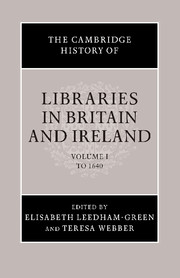Book contents
- Frontmatter
- Introduction
- The physical setting
- Part One The medieval library
- Part Two Reformation, dissolution, new learning
- Part Three Tools of the trade
- Part Four Libraries for leisure
- Part Five Organisation and administration
- 24 Library administration (c. 1475 to 1640)
- 25 Libraries and the organization of knowledge
- Select bibliography
- General index
- Index of manuscripts
- References
25 - Libraries and the organization of knowledge
from Part Five - Organisation and administration
Published online by Cambridge University Press: 28 March 2008
- Frontmatter
- Introduction
- The physical setting
- Part One The medieval library
- Part Two Reformation, dissolution, new learning
- Part Three Tools of the trade
- Part Four Libraries for leisure
- Part Five Organisation and administration
- 24 Library administration (c. 1475 to 1640)
- 25 Libraries and the organization of knowledge
- Select bibliography
- General index
- Index of manuscripts
- References
Summary
When, in 1574, the year after his death, John Caius’s Historia Cantebrigiensis Academiae was published in London, it contained a catalogue of most of the books in Cambridge University Library. The list was the first to be printed of any institutional British library. It represented a collection depleted after four decades of scholarly, educational and religious turmoil. The mid-sixteenth century revolution in the universities had roots in secular learning as well as in religion and politics, in debate and in neglect, as well as in violence and prejudice. Like those at Oxford, and those of the colleges at Cambridge, the catalogue of the library belonging to the University of Cambridge bore witness to these educational and religious upheavals, in losses as well as in what had survived.
As presented in Caius’s account, the catalogue was of manuscripts and printed books, the two media listed separately but under the same subject heads. Thus it included not only the manuscript of Boethius’ De consolatione philosophiae that had belonged to the university since the fifteenth century, but also Greek books presented by Cuthbert Tunstall in 1529: editions from the presses of Aldus Manutius and others, the edition princeps of Homer, and a number of Greek manuscripts. The list in Caius’s book was, furthermore, a list of what were here called veteres libri, and the purpose in offering it was at least partly as an invitation to others to provide the necessary modern complement – especially of printed books. By arranging this survey in an order opening with Greek literature and language, perhaps Caius and his colleagues made clear their humanist intent.
Information
- Type
- Chapter
- Information
- The Cambridge History of Libraries in Britain and Ireland , pp. 592 - 615Publisher: Cambridge University PressPrint publication year: 2006
References
Accessibility standard: Unknown
Why this information is here
This section outlines the accessibility features of this content - including support for screen readers, full keyboard navigation and high-contrast display options. This may not be relevant for you.Accessibility Information
- 2
- Cited by
